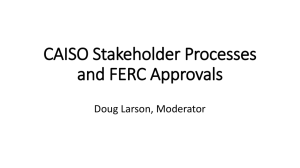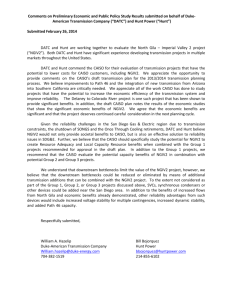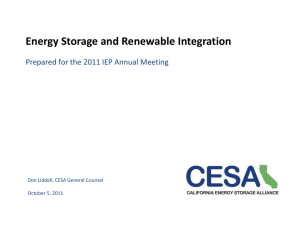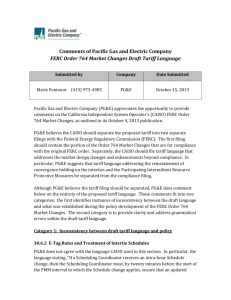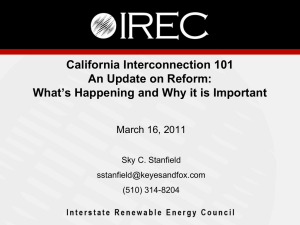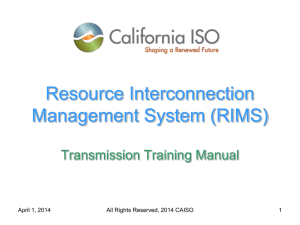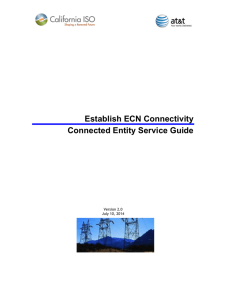BAMx Comments on Draft 2015-2016 Study Plan
advertisement
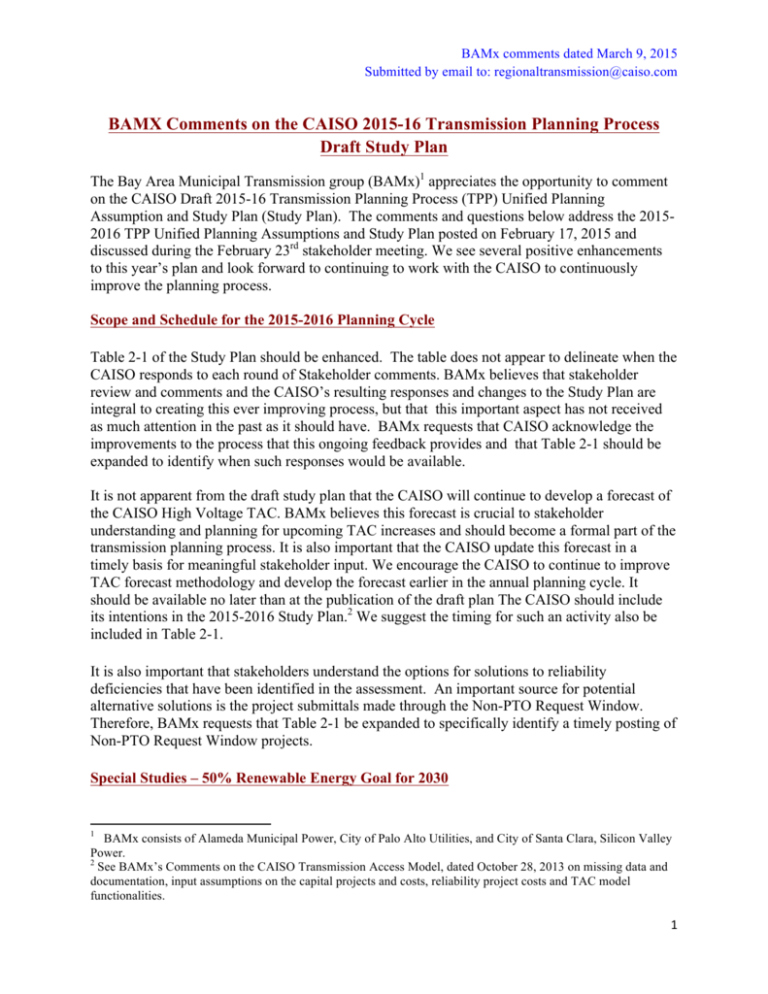
BAMx comments dated March 9, 2015 Submitted by email to: regionaltransmission@caiso.com BAMX Comments on the CAISO 2015-16 Transmission Planning Process Draft Study Plan The Bay Area Municipal Transmission group (BAMx)1 appreciates the opportunity to comment on the CAISO Draft 2015-16 Transmission Planning Process (TPP) Unified Planning Assumption and Study Plan (Study Plan). The comments and questions below address the 20152016 TPP Unified Planning Assumptions and Study Plan posted on February 17, 2015 and discussed during the February 23rd stakeholder meeting. We see several positive enhancements to this year’s plan and look forward to continuing to work with the CAISO to continuously improve the planning process. Scope and Schedule for the 2015-2016 Planning Cycle Table 2-1 of the Study Plan should be enhanced. The table does not appear to delineate when the CAISO responds to each round of Stakeholder comments. BAMx believes that stakeholder review and comments and the CAISO’s resulting responses and changes to the Study Plan are integral to creating this ever improving process, but that this important aspect has not received as much attention in the past as it should have. BAMx requests that CAISO acknowledge the improvements to the process that this ongoing feedback provides and that Table 2-1 should be expanded to identify when such responses would be available. It is not apparent from the draft study plan that the CAISO will continue to develop a forecast of the CAISO High Voltage TAC. BAMx believes this forecast is crucial to stakeholder understanding and planning for upcoming TAC increases and should become a formal part of the transmission planning process. It is also important that the CAISO update this forecast in a timely basis for meaningful stakeholder input. We encourage the CAISO to continue to improve TAC forecast methodology and develop the forecast earlier in the annual planning cycle. It should be available no later than at the publication of the draft plan The CAISO should include its intentions in the 2015-2016 Study Plan.2 We suggest the timing for such an activity also be included in Table 2-1. It is also important that stakeholders understand the options for solutions to reliability deficiencies that have been identified in the assessment. An important source for potential alternative solutions is the project submittals made through the Non-PTO Request Window. Therefore, BAMx requests that Table 2-1 be expanded to specifically identify a timely posting of Non-PTO Request Window projects. Special Studies – 50% Renewable Energy Goal for 2030 1 BAMx consists of Alameda Municipal Power, City of Palo Alto Utilities, and City of Santa Clara, Silicon Valley Power. 2 See BAMx’s Comments on the CAISO Transmission Access Model, dated October 28, 2013 on missing data and documentation, input assumptions on the capital projects and costs, reliability project costs and TAC model functionalities. 1 BAMx comments dated March 9, 2015 Submitted by email to: regionaltransmission@caiso.com BAMx supports the effort in this planning cycle to better understand the potential impacts that a California 50% renewable energy goal may have on the electric transmission infrastruture needs. The effort can provide valuable information as to where infrastructure improvements may be required, but also provide guidance to the procurement process as to how such potentially costly transmission upgrades may be avoided. The CAISO identified an important distinction in the manner in which this study will differ from past studies of a 33% RPS goal. This study plan will assume the incremental renewable generation beyond the 33% RPS will be energy-only resources. BAMx further applauds the manner in which the CAISO clarified that the 50% RPS goal is not State Policy at this time, nor is the assumption of 50% level for RPS resources, as opposed to a expanded definition of renewable resources, a necessary part of the Governor’s proposal. BAMx encourages the CAISO to continue to make this clear to stakeholders as it performs this extra scenario. Furthermore, the study is to estimate the expected amount of congested related curtailment associated with the renewable portfolios. The CAISO indicated in the February 23rd stakeholder meeting that “the (special) study will also consider what transmission could then be rationalized based on cost effectively reducing renewables curtailment (from a customer perspective).” BAMx fully supports this study approach for the following reasons: • To date there has been little need identified for additional system capacity. Therefore, assuming more robust transmission requirements associated with an incremental energy obligation may place unnecessary impediments toward meeting this enhanced RPS goal in addition to any increased consumer costs. • In addition to transmission costs, the environmental consequences that new transmission infrastructure creates puts this new infrastructure at odds with the environmental benefit of new generation. • Identification of areas of potential congestion as well as its magnitude and duration provides important information to the procurement function in evaluation of renewable energy offers from such areas. • Recognition that there may be some level of economical congestion on the grid will allow better accommodation of the associated costs between the renewable energy developers and LSEs. BAMx requests that the base cases for the incremental 50% RPS portfolio be included in the materials made available to stakeholders. To faciliate understanding of these cases, the resources making up the 33% RPS base portfolio should be distinguished from the incremental resources necessary for the 50% renewable portfolio.3 Communication of the study results will be highly important. There are many aspects associated with the safe and reliable operation of the California electric system. While electric infrastructure is a critical component necessary to integrate higher levels of renewable generation, other aspects such as resource integration, disturbance performance (including 3 This is particularly important as the version of the CPUC RPS calculator used to develop the 33% RPS and the one proposed to be used for the 50% renewable portfolio are different in its resource selection methodology and nomenclature. 2 BAMx comments dated March 9, 2015 Submitted by email to: regionaltransmission@caiso.com governor response, inertia, short circuit current, etc.) and cost are similarly important. Therefore, communication concerning the results of the transmission study in this TPP cycle must be carefully crafted so that the audience is aware that this analysis addresses only a fraction of the considerations necessary for an electric system to be sufficiently flexible to accommodate a higher level of renewable generation. Generation Assumptions Once-Through Cooling (OTC) Units While there has been much focus on the retirement/repower of the OTC units in Southern California (along with the early retirement of SONGS), previous cycles have not identified significant system reliability issues with the remaining OTC units in the San Francisco Bay Area.4 BAMx urges the ongoing monitoring of the potential reliability impacts if these facilities were shut down with short notice. As was seen most recently in the case of the Coolwater Power Plant5, current owners can make quick decisions to shut down existing power plants if there is no longer a viable business case for them going forward. With these consideration in mind, BAMx supports modeling the Bay Area OTC as off-line once their compliant dates are reached. Also, unlike the modeling in the 2014-15 Transmission Planning cycle, Pittsburg Unit 7 should also be modeled as shut down once Units 5 and 6 are shut down. The linkage in the operation between these units has been discussed at several recent stakeholder meetings. While the Study Plan indicates that the owner has a possible plan to use the Unit 7 cooling tower for Units 5 and 6, it is predicated on obtaining a long-term Power Purchase and Tolling Agreement (PPTA). There is no indication that such an agreement is imminent. Therefore, it is important to understand potential impacts to the system sufficiently in advance to allow consideration of a full range of options whether the absence of the power plant may lead to reliability issues. Qualifying Facility (QF) Generation Retirements In the last planning cycle, certain transmission upgrades were justified in part due to potential QF retirements. QF plants to be modeled as off-line in the reliability assesment need to be fully identified in the Study Plan as well as the criteria for assuming that they will no longer operate once their current power purchase agreements expire. In the event reliability issues are identified associated with a QF shut down, the findings should be presented sufficiently in advance for a full range of options to be considered, including targeted procurement within the CPUC Long Term Procurement Plan (LTPP). Preferred Resources BAMx is highly supportive of the major strides made by the CAISO in the 2013-2014 Transmission Plan in identifying the likely impact of preferred resources on the transmission grid in the LA Basin and San Diego area following the shut down of SONGS. While the CAISO continued this important work in the 2014-2015 TPP, it has not expanded beyond its original limited geographic area. For example, we have not found any evidence of preferred resources 4 The remaining Greater Bay Area LCR plant being Pittsburg Power Plant, though due to its proximity Moss Landing Power Plant should be monitored as well. 5 The owner of Coolwater, NRG, also owns the Pittsburg Power Plant. 3 BAMx comments dated March 9, 2015 Submitted by email to: regionaltransmission@caiso.com being considered as the mitigation solutions considered by the CAISO in the PG&E area. We encourage full recognition by the CAISO of the ability of funded preferred resources to offset the need for transmission and to support the further development of these resources when their expected benefits, including offsetting the need for additional transmission projects, exceeds their expected ratepayer costs in the 2015-16 TPP cycle. Other (non-QF) Generation Retirements The Study Plan continues to identify that “Other Retirements” will include, unless otherwise noted, retirement of resources with an age of 40 years or more (excluding renewable and hydroelectric resources). BAMx requests that Table A3-1 in the Study Plan be expanded to include all generators that will reach a life of 40 years during the planning horizon, identifying specifically which will be assumed to retire and which will be assumed to remain operational. Similar to the discussion of QF retirements above, BAMx recommends that in the event reliability issues are identified associated with any such retirement assumptions, the findings should be presented sufficiently in advance for a full range of options to be considered, including targeted procurement within the CPUC Long Term Procurement Plan (LTPP). Major Path Flows The Study Plan identifies major path flow assumptions. While we understand the need to study stressed system considerations to understand system limitations, capital upgrades to maintain such transfer capabilities under stressed system conditions may not be cost effective. For example, transmission upgrades to maintain the capability to reliably flow 5,400 MW south-tonorth on Path 15 under Summer Off-peak conditions may not provide a sufficient benefit to justify the cost. We assume that redispatch of generation could be used to address any criteria violations. If the system lacks sufficient flexibility to redispatch around such limitations, it may be more symptomatic of a resource issue rather than a transmission capacity limition. We are encouraged that the Study Plan also identifies that the CAISO will consider lower cost alternatives to the construction of transmission additions or upgrades in action plans to address any violations of criteria that are identified due to the path flow assumptions. However, we urge caution that these assumptions do not also drive the need for transmission solutions in other studies, such as the GIDAP, without a similar consideration of lower cost alternatives. BAMx appreciates the opportunity to comment on the CAISO 2015-16 Transmission Plan. BAMx would also like to acknowledge the significant effort of the CAISO staff to develop the plan to date, as well as the staff’s willingness to work with the stakeholders in the process to more fully develop it. We hope to work with the CAISO staff to continue to improve and enhance its capabilities. If you have any questions concerning these comments, please contact Barry Flynn (888-634-7516 and brflynn@flynnrci.com) or Pushkar Wagle (888-634-3339 and pushkarwagle@flynnrci.com) or Robert Jenkins (888-634-0777 and robertjenkins@flynnrci.com) 4
